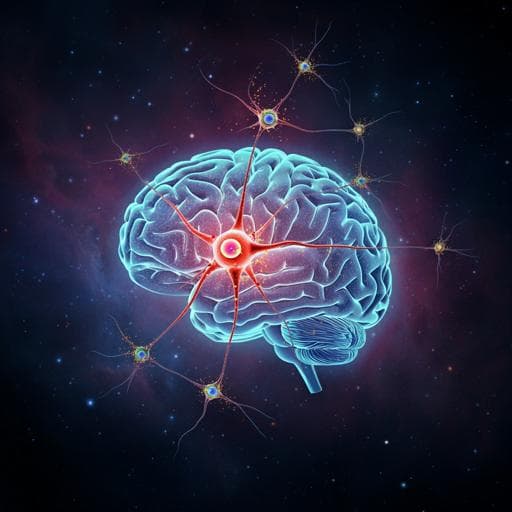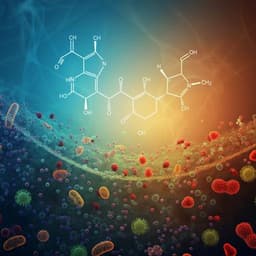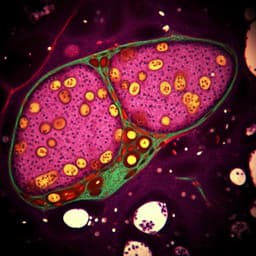
Space Sciences
Spatially resolved multiomics on the neuronal effects induced by spaceflight in mice
Y. Masarapu, E. Cekanaviciute, et al.
This fascinating study delves into how spaceflight affects the mouse brain, uncovering significant changes in neurogenesis and synaptic functions that mirror neurodegenerative disorders. Conducted by a team of experts including Yuvarani Masarapu and Egle Cekanaviciute, the research provides a unique perspective on the impacts of space on the central nervous system.
~3 min • Beginner • English
Introduction
Spaceflight poses multiple physiological risks including DNA damage and oxidative stress from galactic cosmic radiation, musculoskeletal degeneration from microgravity, circadian disruption, microbial dysbiosis, and CNS injury. Simulated spaceflight stressors and radiation have been shown to cause neuroinflammation, neurodegeneration, neurovascular damage, and behavioral deficits in animal models. Because direct astronaut studies are necessarily minimally invasive and limited at the molecular level, rodent models enable subcellular-to-behavioral investigations. This study aimed to define how spaceflight alters molecular programs in specific brain regions and cell types by integrating single-nucleus multiomics (RNA expression and chromatin accessibility) with spatial transcriptomics in brains of female BALB/c mice flown on the ISS during the RR-3 mission, contrasted with ground controls. By combining cellular-resolution and spatial context, the goal was to identify region- and cell type–specific mechanisms (for example, synaptogenesis, neurogenesis, neuronal transmission) and potential pathways implicated in neurodegenerative-like processes, immune dysfunction, and circadian/mitochondrial perturbations to inform countermeasure development for long-duration missions.
Literature Review
Prior work indicates that space environment stressors, including galactic cosmic radiation and microgravity, induce CNS-relevant pathologies such as neuroinflammation, neurodegeneration, neurovascular compromise, and cognitive/behavioral deficits in rodents. Microgravity-driven fluid shifts in low-Earth orbit affect cardiovascular and CNS systems, and astronaut neuroimaging has revealed white matter and intracranial fluid changes. Simulated radiation exposures at Mars mission–relevant doses impair synaptogenesis and neurogenesis. While single-cell approaches provide cellular composition and perturbation responses, spaceflight sample collection often requires carcass freezing, making single-nucleus transcriptomics more feasible; however, single-nucleus methods lack spatial context, which spatial transcriptomics can provide. Collectively, these studies motivate high-resolution, spatially resolved, cell type–specific analyses of CNS responses to spaceflight.
Methodology
Study design and samples: Brains from 12-week-old female BALB/c mice flown on the ISS (RR-3 mission; n=3, F1–F3) and matched ground controls (n=3, G1–G3) were analyzed. Mice were housed 39–42 days in Rodent Habitat; ground controls were maintained under matched hardware and environmental conditions (12:12 light/dark, identical diet, temperature, humidity, and CO2). At mission end, animals were euthanized and carcasses stored at −80 °C. RNA integrity was high (mean RIN 9.15). Experimental overview: One hemisphere per brain was processed for Spatial Transcriptomics (ST; 10x Genomics Visium) focusing on hippocampal-containing coronal sections (two sections per hemisphere). The contralateral hemisphere was used for single-nucleus multiomics (snMultiomics; 10x Genomics Single Cell Multiome ATAC+Gene Expression), enabling paired snRNA-seq and snATAC-seq from the same nuclei. Nuclei isolation and library prep: Nuclei were extracted via lysis and pestle homogenization, filtered (40 µm), FACS-sorted (7-AAD+ singlets), and used to generate Multiome libraries per manufacturer protocols. Gene expression libraries were sequenced on Illumina NextSeq2000 (Read1 28 bp, Read2 120 bp); ATAC-seq libraries on NextSeq2000 (paired-end 50 bp). Spatial gene expression libraries (Visium) were prepared after tissue optimization to determine permeabilization, and sequenced on Illumina NovaSeq (most libraries) or NextSeq500 (some), with Read1 28 bp, Read2 120 bp. Data processing—ST: Space Ranger (v1.0.0) aligned reads to mm10-3.0.0; count matrices and H&E images were used in Seurat (v4.0.1) and STUtility (v0.1.0). Filters included gene/spot thresholds, exclusion of MALAT1, ribosomal, and mitochondrial genes. Normalization and integration used SCTransform and Harmony (batch correction by section). PCA (50 PCs; 35 retained) and clustering (FindClusters resolution 0.35; dims 1–35) were performed; UMAP visualized clusters. Data processing—snMultiomics: Cell Ranger ARC (v2) processed snRNA-seq/snATAC-seq to mm10 (10x 2020-A). Analysis in Seurat (v4.1.0)/Signac (v1.6.0) included quality filtering (reads, genes, peaks, fraction of ATAC reads in peaks, TSS enrichment), doublet removal (DoubletFinder cutoff 0.6), RNA normalization (SCTransform v2 with cell cycle regression), ATAC normalization (TF–IDF). Batch effects were mitigated with Harmony (group by bio_origin). WNN integration (FindMultiModalNeighbors) and clustering (resolution 0.2) were applied; UMAP for visualization. Differential analyses: Cluster marker DEGs used Wilcoxon rank-sum (Seurat FindAllMarkers; expressed in ≥25% cells; log2FC>0.25; FDR<0.05). Flight vs ground DE in each cell type used MAST mixed models with sample as random effect (genes expressed in ≥30% of cells; FDR<0.05). Differential chromatin accessibility used analogous mixed models. Motif analysis: chromVAR (v1.16.0) with JASPAR motifs, mixed models via lmer (lme4), FDR<0.05. Deconvolution and spatial analyses: Stereoscope inferred cell type proportions per ST spot from snMultiomics. Spatial ligand–receptor (LR) co-expression used SpatialDM (v0.1.0), including global selection and local spot selection; differential testing via likelihood ratio tests. CellPhoneDB (v3) analyzed LR interactions between multiomics clusters (ortholog mapping to human required). Pathway modeling: MISTy related cell type abundances and PROGENY-inferred pathway activities (via decoupler-py) within spots (intraview) and neighborhoods (paraview) up to two spots away; differential interactions assessed with Student’s t-tests and BH correction. Gene regulatory network: CellOracle built a brain tissue–specific GRN from multiomics; TF activities were inferred in ST (decoupler-py). Metabolic pathway enrichment: Genes were ranked by flight-vs-ground fold changes per cluster (Seurat FindMarkers), mapped to mouse orthologs of RECON3D metabolic genes (via HGNC HCOP and manual curation), and tested by fgsea (v1.22.0), adjusting p-values for multiple testing. Validation: smFISH (RNAscope V2) validated expression changes of Adcy1 (green) and Gpc5 (red) in hippocampal sections from an independent RR-10 mouse cohort (3 flight, 2 ground), quantified in ImageJ.
Key Findings
Data quality and clustering: snMultiomics captured 21,178 nuclei with averages of 3,140 UMIs/nucleus and 9,217 ATAC peaks/nucleus; flight vs ground snMultiomics expression showed high correlation (Pearson r=0.95, p<0.05). ST captured 29,770 spots with 10,884 UMIs/spot and 3,755 genes/spot on average; flight vs ground ST expression correlated strongly (r=0.99, p<0.05). Eighteen snMultiomics clusters were identified and grouped into 11 functional macro-categories; 18 ST clusters mapped major brain structures (cortical layers, hippocampal CA1/CA3/dentate gyrus, thalamus, striatum, hypothalamus/pituitary, corpus callosum, cerebral peduncles) based on marker genes. Differential expression: Across multiomics clusters, 825 flight-associated DEGs were identified, enriched in neuronal development, axonal/dendritic outgrowth, and synaptic transmission (e.g., GABAergic). Comparing these 825 DEGs to bulk RR-3 brain RNA-seq (629 DEGs; p<0.05) revealed 11 overlapping genes (hypergeometric p≈0.0158), with only 2 (Gabra6, Kctd16) changing in the same direction, highlighting cell type specificity. Cross-dataset comparison with 11 NASA OSDR mouse datasets yielded 461 overlapping DEGs (combined p<0.05). Spatial DEGs: 4,057 DEGs were found in 7/18 ST clusters. The most prominent changes occurred in cortical neurons (bottom layers; ST cluster 9) with 3,208 DEGs (1,808 up, 1,400 down), implicating neuronal development and synaptic transmission changes across somatosensory, motor, and visual cortex; CA3 neurons showed 21 DEGs. Pathway analyses indicated neurodegeneration-associated processes, including protein misfolding/abnormal clearance in cortical neurons. Spatial deconvolution and mapping: Stereoscope linked several multiomics clusters with ST clusters (e.g., synaptic transmission with cortical and hypothalamic regions; myelination with white matter tracts), suggesting cortical synaptic transmission effects (neurons and astrocytes) and striatal dopaminergic development changes. Cell–cell communication: CellPhoneDB identified 4 significantly upregulated LR interactions between astrocytes (multiomics cluster 4) and GABAergic synaptic transmission (cluster 11), including EGFR-related and VEGFA–GRIN2B interactions; none were significantly downregulated. SpatialDM detected 1,260 spatially co-expressed LR pairs overall and 134 differentially regulated pairs between flight and ground. Chromatin and TF motifs: Flight was associated with reduced accessibility of Zic1, Zic2, and Atoh1 motifs in astrocytes (cluster 4) and increased accessibility of Pou5f1 (Oct4) and Sox2 motifs in GABAergic neurons (cluster 11), consistent with altered differentiation states. Decreased accessibility of Pparg, Rxra, and Nr2f6 motifs in telencephalic interneurons suggests heightened inflammatory responses and potential circadian dysregulation. Signaling topology (MISTy): Neurovascular cell abundance co-localized with decreased MAPK signaling in flight. Paraview analyses showed: less negative correlation of EGFR signaling with glutamatergic neurons; more negative correlation of MAPK with cholinergic/monoaminergic/peptidergic neurons; increased TGF-β signaling near GABAergic interneurons; reduced WNT signaling in class II glutamatergic neurons. GRN-based inference indicated decreased MAPK signaling associates with increased GLIS3 and decreased LEF1 activity in neurovasculature. Metabolism: GSEA indicated inhibition of oxidative phosphorylation (notably Complex I), and reductions in glycolysis/gluconeogenesis, fructose/mannose metabolism, arachidonic acid metabolism, and fatty acid synthesis—consistent with spaceflight-related mitochondrial dysfunction and suggesting astrocyte metabolic perturbations. Validation: RNAscope smFISH confirmed significant upregulation of Adcy1 (notably in hippocampus; linked to neuronal activity) and Gpc5 (upregulated in astrocytes) in flight samples, aligning with ST and multiomics findings.
Discussion
Integrating single-nucleus multiomics with spatial transcriptomics revealed that spaceflight alters gene expression programs related to neurogenesis, synaptogenesis, neuronal development, and synaptic transmission across specific brain regions (cortex, hippocampus, striatum, neuroendocrine structures). The joint RNA–ATAC perspective uncovered astrocyte activation, immune dysfunction signatures, and region-specific neuronal changes, including potential striatal dopaminergic synapse perturbations. Spatial pathway analyses identified neurodegeneration-like patterns (protein misfolding/clearance), mitochondrial pathway inhibition, and altered intercellular signaling (MAPK, TGF-β, WNT, EGFR) in region- and cell type–specific contexts. Motif accessibility changes suggest shifts toward reduced differentiation in certain neuronal populations and pro-inflammatory tendencies. Collectively, these findings address the central question by demonstrating that spaceflight elicits coordinated, cell type– and region-specific molecular remodeling in the CNS that resembles aspects of aging and neurodegenerative disease, has circadian and metabolic components, and involves astrocyte–neuron communication. The study underscores the utility of combined spatial and single-nucleus multiomics to dissect CNS risks relevant to long-duration missions and to guide countermeasure development.
Conclusion
This work provides a high-resolution, spatially anchored, cell type–specific map of CNS molecular alterations induced by spaceflight in female mice, revealing widespread changes in neurogenesis, synaptogenesis, neuronal signaling, immune and astrocyte function, and metabolism, with pathway similarities to neurodegenerative conditions. The integration of snRNA-seq/snATAC-seq with ST enabled discovery of region-specific and ligand–receptor-mediated effects not evident in bulk analyses. The openly shared datasets and interactive portal facilitate comparative analyses across missions. Future research should increase statistical power and anatomical coverage, include post-flight reacclimation to determine persistence of changes, investigate neuroimmune outcomes in depth, assess sex differences by including male cohorts, and extend to human CNS organoids and automated models for deep-space missions. Therapeutic avenues may include neuroprotective and mitochondrial-targeted strategies informed by the observed pathways.
Limitations
Statistical robustness was constrained by legacy sample collection not optimized for spatial transcriptomics, leading to uneven brain morphology across sections and limiting differential analyses to a subset of clusters; larger sample sizes and cross-mission replication are needed. Only female mice were analyzed (common in spaceflight rodent studies for housing reasons), limiting assessment of sex-specific CNS risks; future studies should compare both sexes. Additionally, animals were not studied after reacclimation to Earth, so the persistence and reversibility of spaceflight-induced changes remain to be determined.
Related Publications
Explore these studies to deepen your understanding of the subject.







